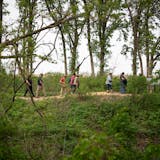When COVID-19 restrictions forced the Rev. Bob White to abruptly shut down his church in Victoria in the spring of 2020, staffers scrambled to launch livestreaming masses online and, on a whim, added an outdoor Sunday mass in the parking lot.
The Facebook masses have ended, but outdoor worship is now a part of life at St. Victoria Catholic Church. At 10:45 a.m. on Sunday, White celebrates mass in the tree-lined parking lot, presiding over a sea of the faithful in lawn chairs and parked cars at what has become the parish's most popular liturgy.
It's just one example of how innovations sparked by COVID restrictions have gone mainstream, changing the religious landscape across Minnesota and around the nation.
St. Victoria's, for example, will continue livestreaming baptisms and funerals on request for loved ones unable to attend. White will keep doing his weekly talk show on Facebook to stay in touch with members, and the church will continue to promote digital donations instead of weekly envelopes dropped in an usher's basket.
"Why didn't we think of this before?" White said. "I'm surprised by how so much of this is now part of our culture. It's shifting the way we connect with people, reaching people we otherwise would not reach."
Religious leaders were reeling in March of last year when they suddenly had to lock the doors and pivot to socially distanced alternatives for worship, religious education and other programs. While challenges persist — particularly how to draw the faithful back inside — clergy now say that many of the new ideas have resulted in efficiencies, leaps in technological know-how, and popular adaptations of ancient traditions.
Children with schedules that conflict with religious education class can join from home computers. Congregation members unable to leave home can celebrate holidays virtually with their pastors and even partake in communion-to-go.
Clergy who had spent hours crafting lengthy sermons have found brevity a blessing, and outdoor-lovers revel in open-air worship and events.
![Three weeks ago, Octavio Rodriguez switched from making transmission parts to casting parts for hospital bed brake assemblies at Twin City Die Castings. ] GLEN STUBBE • glen.stubbe@startribune.com Thursday, April 9, 2020 How employee-owned Twin City Die Casting, which just laid off 40 production workers of its 250 employees in what was supposed to be a good year, is trying to accelerate its pivot to growing medical parts business for ventilators, hospital beds, etc as it copes with instan](https://arc.stimg.co/startribunemedia/WNZYKGTZ5IYMUCO3KI5TR3N7WI.jpg?&w=80&ar=1:1&fit=crop)

djoles@startribune.com As boaters flock to Minnesota lakes and rivers this holiday weekend for the unofficial kick-off to the boating season, they'll face more inspections in and out of the water as local cities and counties ramp up their work to stop the spread of invasive species. Across the metro, more boat accesses will be staffed by watercraft inspectors thanks to $10 million funneled to county government programs this year, up from $4.5 million the state allocated last year. ORG XMIT: MIN1505222156290209 ORG XMIT: MIN1506021218440580](https://arc.stimg.co/startribunemedia/34QSKO44B2XKVNUZCO5SLJQSLY.jpg?&w=80&ar=1:1&fit=crop)
